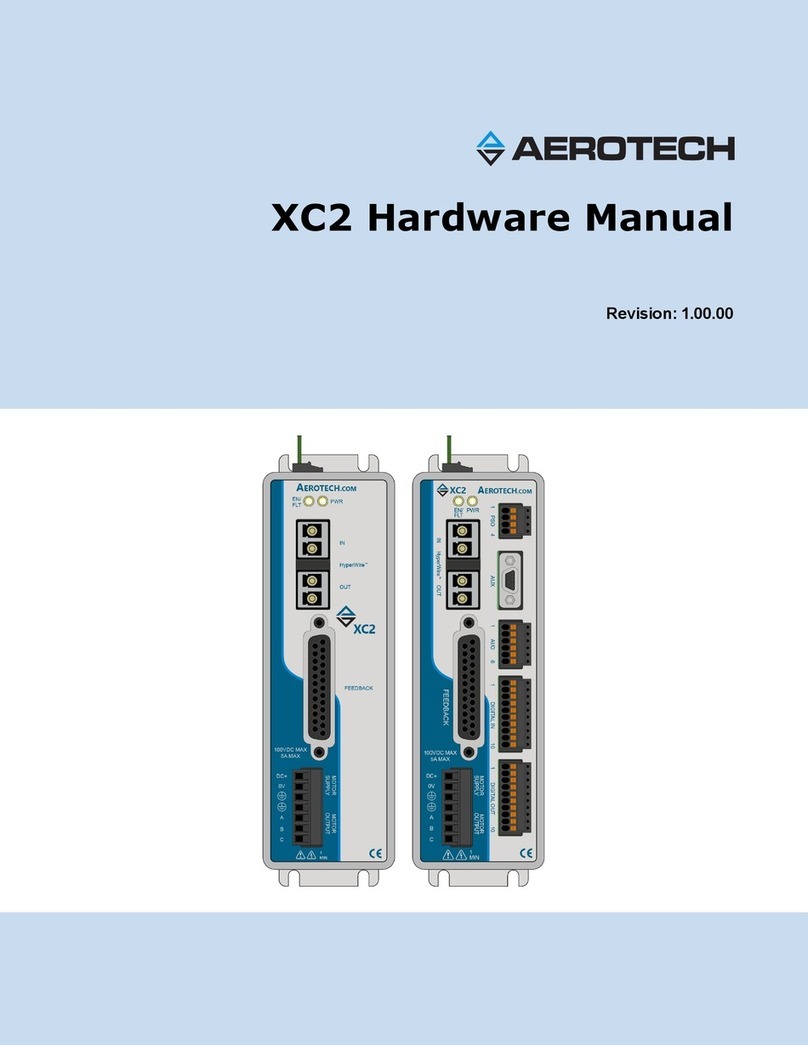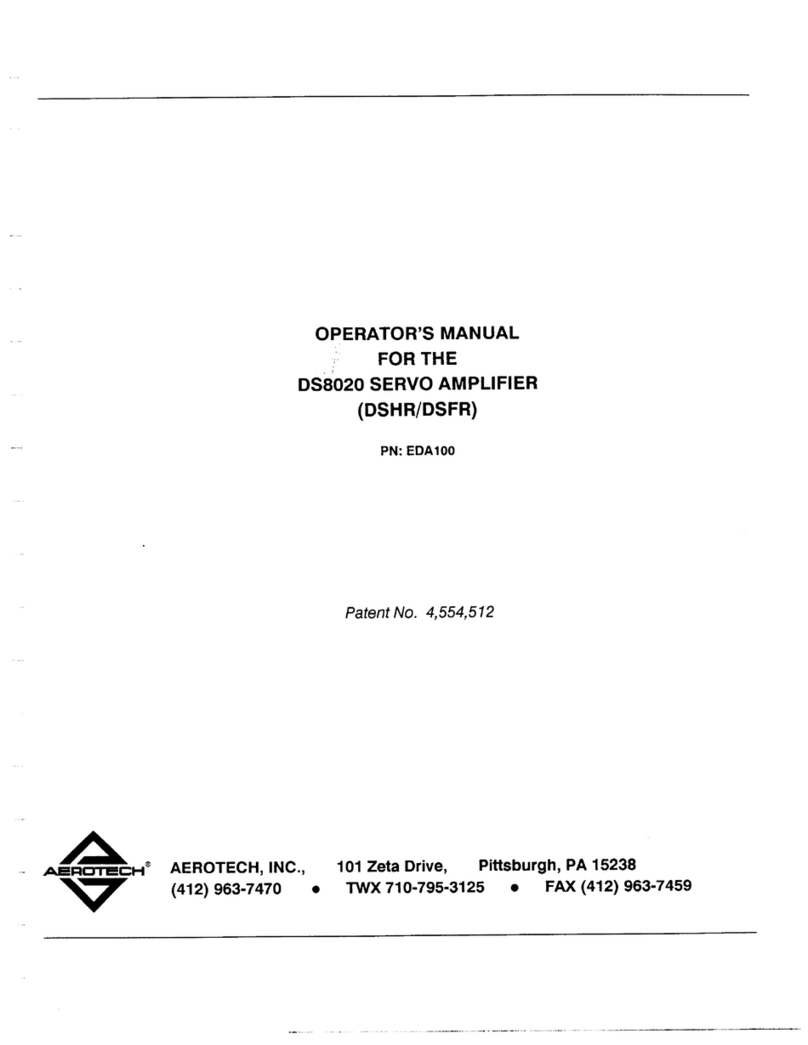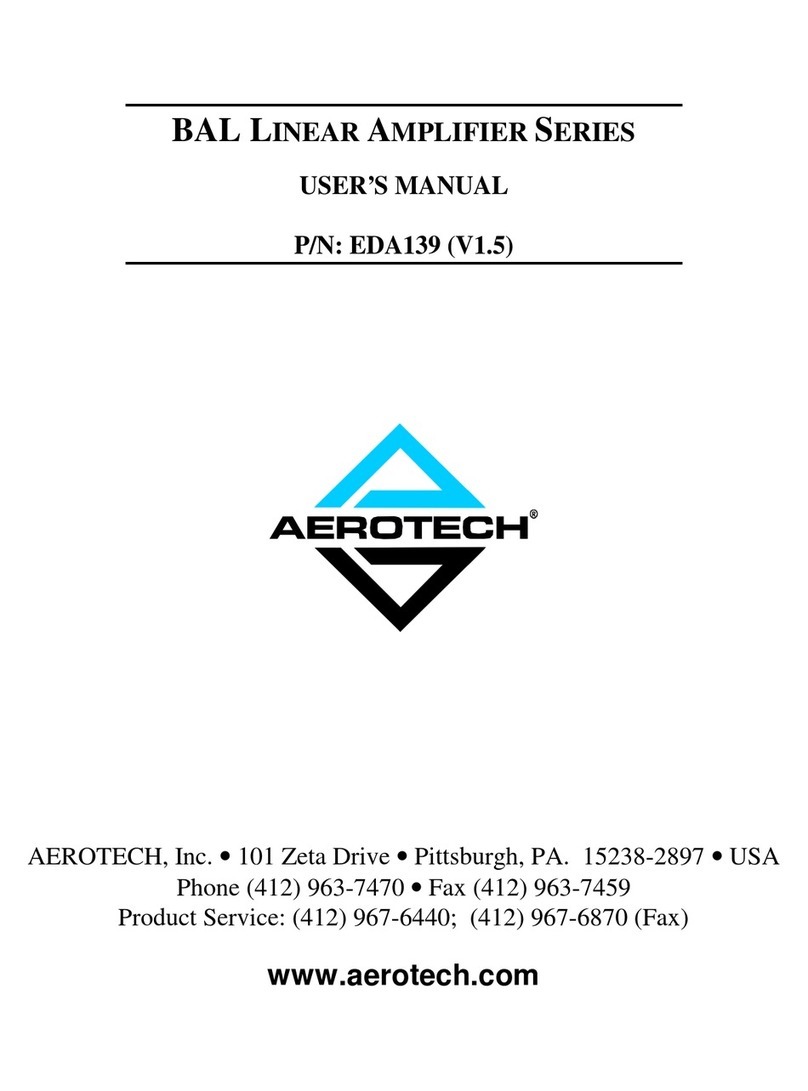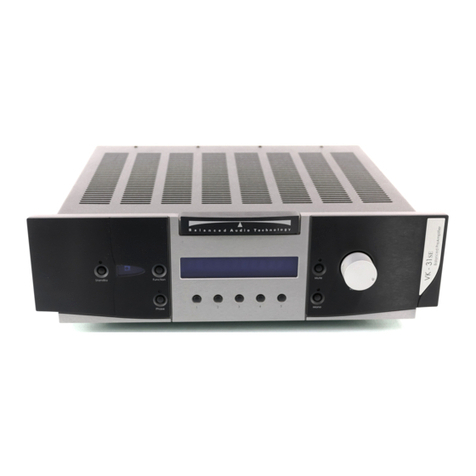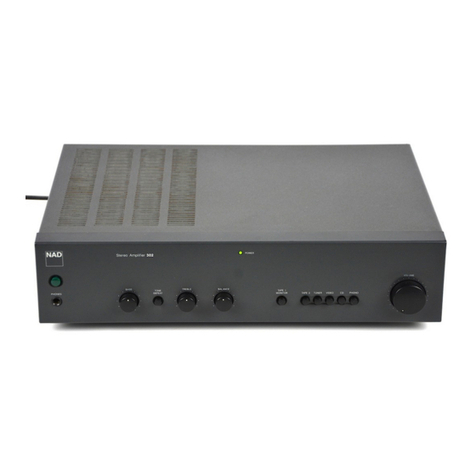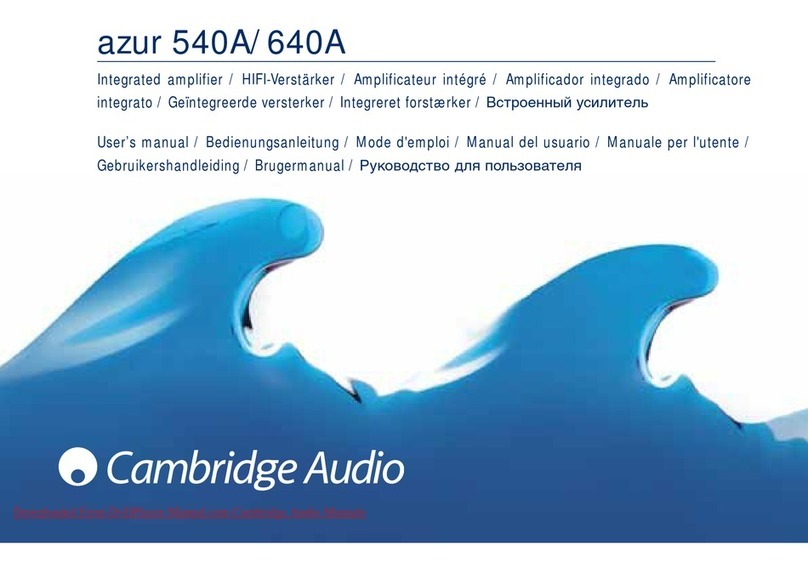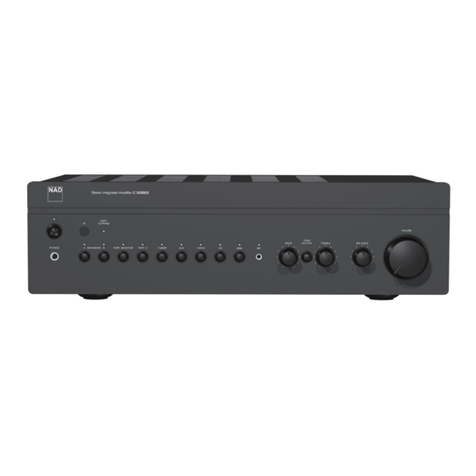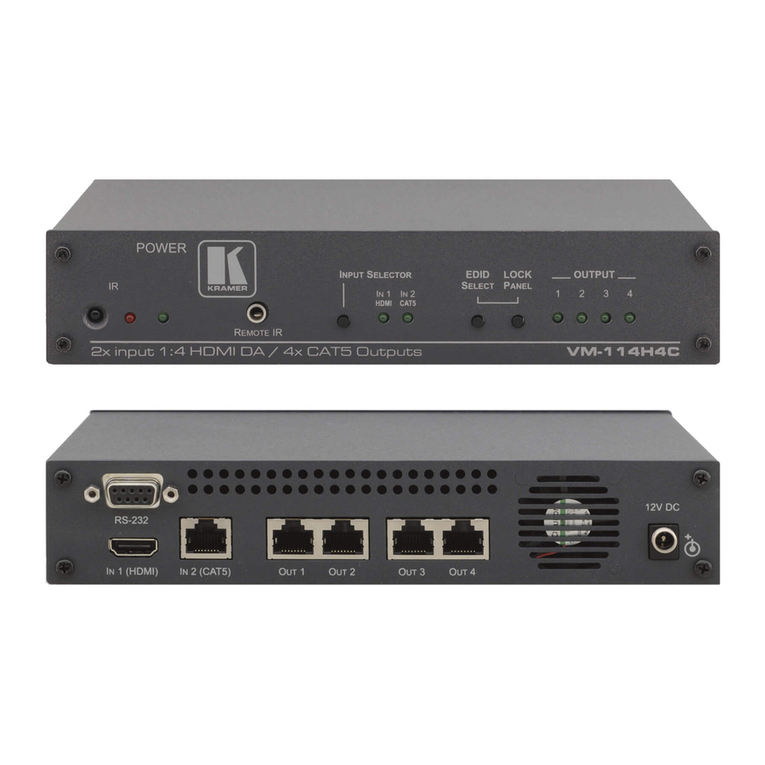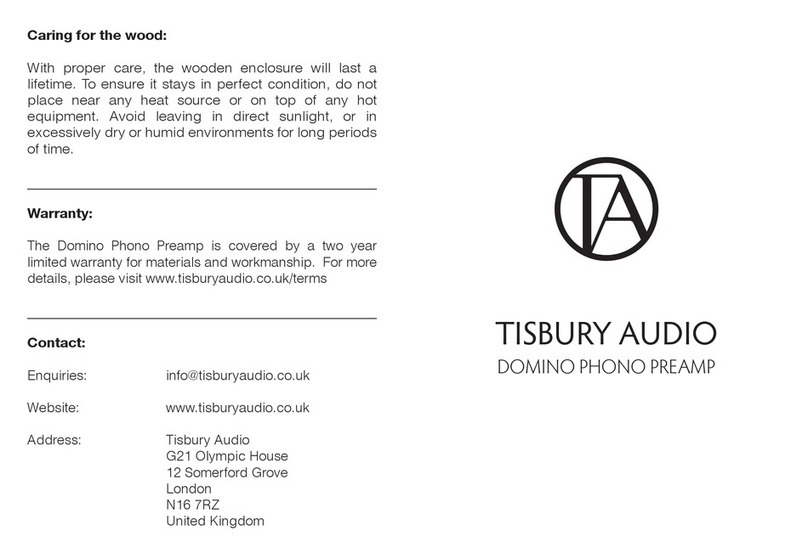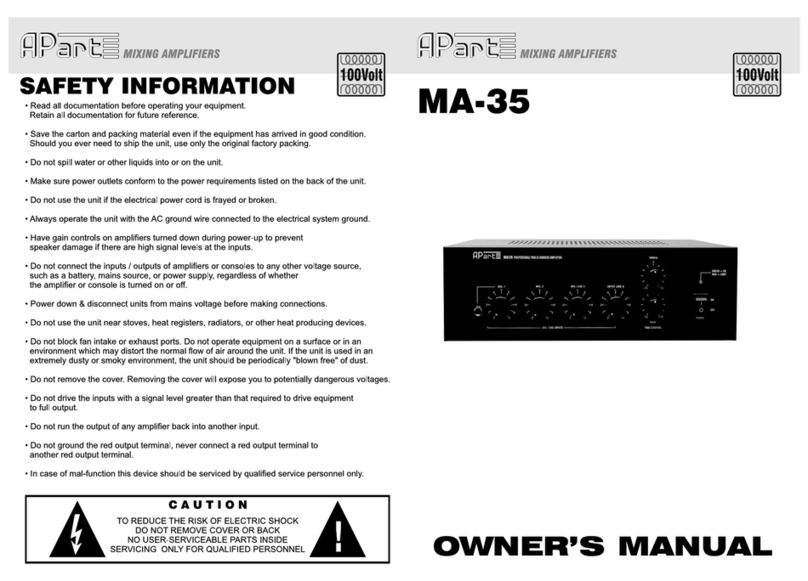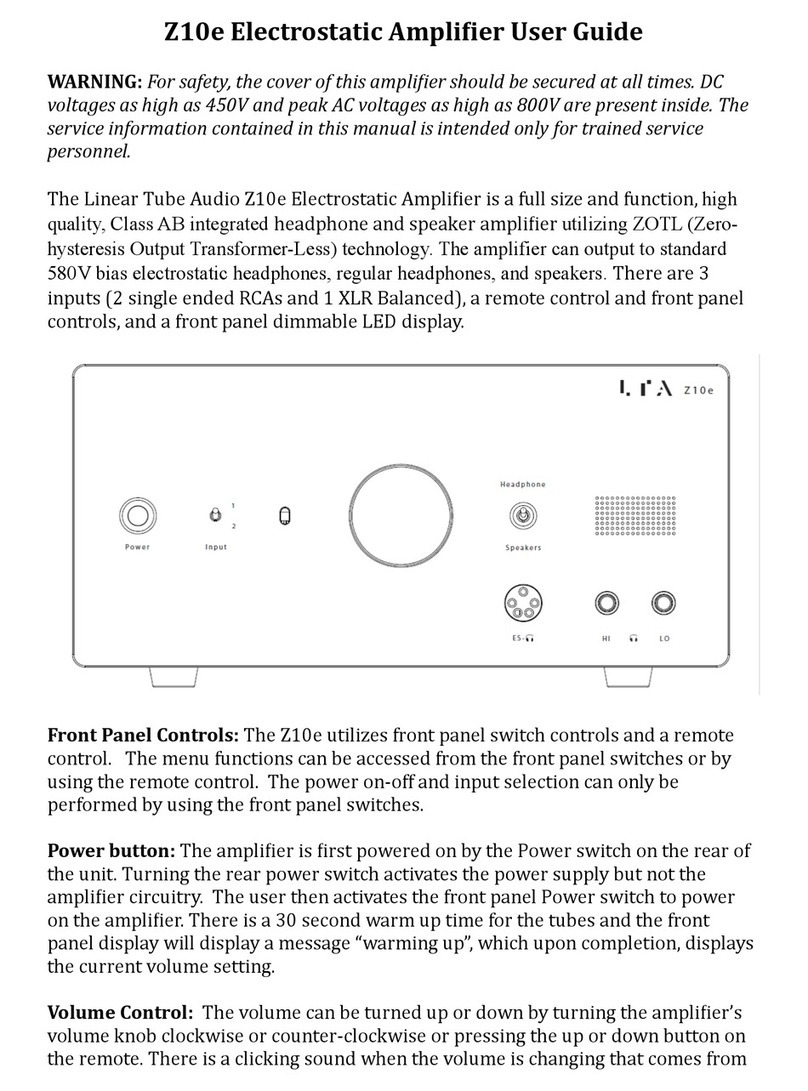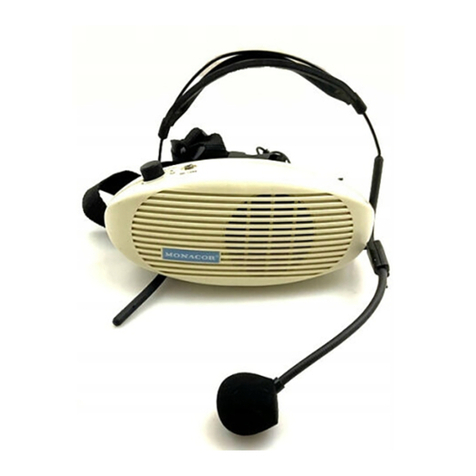Aerotech BA10 SERIES User manual

BA10/20/30 SERIES
USER’S MANUAL
P/N: EDA121 (V1.6)
AEROTECH, Inc. •101 Zeta Drive •Pittsburgh, PA. 15238-2897 •USA
Phone (412) 963-7470 •Fax (412) 963-7459
Product Service: (412) 967-6440; (412) 967-6870 (Fax)
www.aerotech.com

If you should have any questions about the BA10, 20, or 30 and/or comments regarding the documentation, please
refer to Aerotech online at:
http://www.aerotech.com.
For your convenience, a product registration form is available at our web site.
Our web site is continually updated with new product information, free downloadable software and special pricing on
selected products.
The BA Series User’s Manual Revision History:
Rev 1.0a February 21, 1995
Rev 1.1 July 27, 1995
Rev 1.1a November 1995
Rev 1.2 May 23, 1996
Rev 1.3 May 15, 1997
Rev 1.3a September 30,1997
Rev 1.4 February 11, 1998
Rev 1.4a March 8, 2000
Rev 1.5 December 13, 2000
Rev 1.5a February 13, 2001
Rev 1.6 February 5, 2002
© Aerotech, Inc., 2002

BA10/20/30 Series User’s Manual
Table of Contents
Version 1.6 Aerotech, Inc. iii
TABLE OF CONTENTS
CHAPTER 1: INTRODUCTION............................................................................ 1-1
1.1. Product Overview............................................................................... 1-1
1.2. Models, Options and Packages........................................................... 1-2
1.3. BA Drive Package.............................................................................. 1-3
1.4. Hardware Overview and Function...................................................... 1-4
1.4.1. Motor and AC Power Connections....................................... 1-4
1.4.2. DIP Switch........................................................................... 1-5
1.4.3. Potentiometers (POTs)......................................................... 1-6
1.4.4. Connector P1 and Enable Indicator...................................... 1-6
1.4.5. I/O Circuitry......................................................................... 1-9
1.5. Safety Procedures and Warnings...................................................... 1-11
CHAPTER 2: INSTALLATION AND OPERATION........................................... 2-1
2.1. Introduction........................................................................................ 2-1
2.2. Jumper Selections............................................................................... 2-1
2.3. Wiring, Grounding, and Shielding Techniques .................................. 2-4
2.3.1. Minimizing EMI Interference............................................... 2-4
2.3.2. Fusing and Inrush Limiting .................................................. 2-5
2.3.2.1. 40 Volt Option.................................................... 2-6
2.3.3. Minimizing 50/60 HZ Line Interference .............................. 2-7
2.4. Integrated Configurations................................................................... 2-9
2.4.1. Velocity Command Configuration .......................................2-9
2.4.2. Current Command Configuration....................................... 2-10
2.4.3. Dual-Phase Command Configuration................................. 2-11
2.5. Control Connections......................................................................... 2-12
2.5.1. Setup - Torque Command Mode (Current) ........................2-12
2.5.2. Setup - Velocity Command Mode...................................... 2-12
2.5.3. Setup - Dual-phase Command Mode................................................ 2-14
2.6. Motor Phasing Process..................................................................... 2-15
2.6.1. Determining Phase/Hall Sequence ..................................... 2-15
2.7. Current Regulator Adjustment.......................................................... 2-17
CHAPTER 3: TECHNICAL DETAILS.................................................................. 3-1
3.1. Part Number and Ordering Information.............................................. 3-1
3.2. Electrical Specifications..................................................................... 3-2
3.3. BA Amplifier Dimensions.................................................................. 3-5
3.4. 40/80 VDC Power Transformers........................................................ 3-7
CHAPTER 4: TROUBLESHOOTING................................................................... 4-1
4.1. Amplifier Related Problems............................................................... 4-1
APPENDIX A: GLOSSARY OF TERMS ............................................................... A-1
APPENDIX B: WARRANTY AND FIELD SERVICE...........................................B-1
APPENDIX C: CABLE DRAWINGS.......................................................................C-1
INDEX
REVISION HISTORY

Table of Contents
BA10/20/30 Series User’s Manual
iv Aerotech, Inc. Version 1.6
∇∇∇

BA10/20/30 Series User’s Manual
List of Figures
Version 1.6 Aerotech, Inc. v
LIST OF FIGURES
Figure 1-1. BA Series Amplifier........................................................................... 1-1
Figure 1-2. Functional Diagram............................................................................ 1-3
Figure 1-3. Amplifier Hardware............................................................................ 1-4
Figure 1-4. Fault Output........................................................................................ 1-9
Figure 1-5. Enable/Shutdown Inputs..................................................................... 1-9
Figure 1-6. 6Limit Inputs ................................................................................. 1-10
Figure 1-7. Hall and Encoder Inputs................................................................... 1-10
Figure 2-1. BA Board Assembly........................................................................... 2-3
Figure 2-2. Wiring to Minimize EMI and Capacitive Coupling............................ 2-5
Figure 2-3. Fusing and Inrush Limiting................................................................. 2-5
Figure 2-4. 40 Volt Option.................................................................................... 2-6
Figure 2-5. Back-propagation Line Filter Connection .......................................... 2-7
Figure 2-6. Isolation Transformer Connection (eliminates torque
disturbance) ........................................................................................ 2-8
Figure 2-7. Velocity Command Configuration...................................................... 2-9
Figure 2-8. Current Command Configuration ..................................................... 2-10
Figure 2-9. Dual-Phase Command Configuration............................................... 2-11
Figure 2-10. Command Signal Adjustment Portion of the Pre-Amplifier
Circuit............................................................................................... 2-13
Figure 2-11. Motor Phasing .................................................................................. 2-16
Figure 2-12. Three-Phase Current Regulator Circuit ............................................ 2-18
Figure 3-1. BA Amps Side View .......................................................................... 3-5
Figure 3-2. BA Amp Top View (Preferred Mounting)..........................................3-6
Figure 3-3. Preferred Mounting of BA Amplifiers................................................ 3-6
Figure C-1. BA Feedback Cable (PFC).................................................................C-1
Figure C-2. BA10/20/30 Light Duty Brushless Motor Cable (PMC) ....................C-2
∇∇∇

List of Figures
BA10/20/30 Series User’s Manual
vi Aerotech, Inc. Version 1.6

BA10/20/30 Series User’s Manual
List of Tables
Version 1.6 Aerotech, Inc. vii
LIST OF TABLES
Table 1-1. BA Models and Voltage Configurations.............................................1-2
Table 1-2. DIP Switch Functions......................................................................... 1-5
Table 1-3. Potentiometer Functions..................................................................... 1-6
Table 1-4. Connector P1 Pinouts......................................................................... 1-7
Table 2-1. Jumper Selections............................................................................... 2-2
Table 3-1. Ordering Information.......................................................................... 3-1
Table 3-2. Electrical Specifications.....................................................................3-2
Table 4-1. Amplifier Faults, Causes, and Solutions............................................. 4-1
∇∇∇

List of Tables
BA10/20/30 Series User’s Manual
viii Aerotech, Inc. Version 1.6

BA10/20/30 Series User’s Manual
Regulatory Information
Version 1.6 Aerotech, Inc. ix
DECLARATION OF CONFORMITY
Manufacturer’s Name and Address
Aerotech, Inc.
101 Zeta Drive
Pittsburgh, PA 15238-2897
Declares that the product:
Product Name: Brushless Servo Amplifier (BA Series)
Conforms to the following product specifications:
EMC: EN 55011: 1991 Class B Emissions
EN 50082-1: 1992 Immunity
IEC 801-2: 1984
IEC 801-3: 1984
IEC 801-4: 1988
LVD: IEC 204-1
and complies with EMC directive 89/336/EEC.
Pittsburgh, PA David F. Kincel_________________________
February, 1998 Quality Assurance Manager
Robert Novotnak__________________________
Engineer Verifying Compliance
General notes concerning the test setup.
This product was tested at Washington Laboratories, LTD. in Gaithersburgh, MD on
October 19, 1995. The report number is WLL 2956F.
The brushless amplifier was tested with a brushless servomotor. To ensure that the
product passes the conducted emissions tests, a line filter and common mode choke must
be connected to the main inputs. The filter is a Schaffner FN 2070-10-06 and the common
mode choke is a Renco Electronics RL-1329-1200. Ferrite must be added to each line of
the main inputs but not earth ground. In order for the product to conform to the radiated
emission standards, the motor cable must be shielded and the shield must be tied to the
earth ground. Ferrite must also be added (in common mode) to the motor cable but not
around the shield. Finally, a metal 25-pin connector with a metal backshell must be used
when making a connection to the 25-pin receptacle on the amplifier. The shield of the
feedback cable must be tied to the metal backshell. Failure to follow the described
procedures may cause the amplifier/motor to exceed emission limits.
∇∇∇

Regulatory Information
BA10/20/30 Series User’s Manual
xAerotech, Inc. Version 1.6

BA10/20/30
Series User’s Manual Introduction
Version 1.6 Aerotech, Inc. 1-1
CHAPTER 1: INTRODUCTION
In This Section:
•Product Overview..................................................... 1-1
•Models, Options and Packages.................................1-2
•BA Drive Package.................................................... 1-3
•Hardware Overview and Function............................1-4
•Safety Procedures and Warnings............................ 1-11
1.1. Product Overview
The BA series amplifiers are highly reliable brushless servo amplifiers (refer to Figure 1-
1) that are easily adaptable to drive brush or brushless servomotors. The amplifiers are
available in 3 peak output current ratings of 10, 20, and 30 amps. The BA amplifier
package is a complete modular unit that includes heat sink, metal cover, and bus power
supply that operates from 56-230 VAC. Custom packages, such as units without
metalwork for direct cold plate mounting are available for the OEM with special
packaging needs. The BA drives provide the designer with servo drive flexibility for use
in applications such as:
½machine tools
½packaging
½labeling
½x-y stages
½inspection
½medical
½winding
½semiconductor fabrication
½food processing.
Figure 1-1. BA Series Amplifier

Introduction BA10/20/30
Series User’s Manual
1-2 Aerotech, Inc. Version 1.6
1.2. Models, Options and Packages
The BA drives are available in three models with continuous power, ranging from 1,360
to 4,080 watts. A list of these models and the available voltage configurations is shown in
Table 1-1
Table 1-1. BA Models and Voltage Configurations
Model Standard
Voltage
Configuration
Peak Output
Current Continuous
Output Current
(peak)
DC Bus Voltage
Range (Nominal
VDC)*
BA10 160V 10A 5A 80-100V, 80-160V,
80-320V
BA20 160V 20A 10A 80-100V, 80-160V,
80-320V
BA30 320V 30A 15A 160V, 160-320V
*DC Output is a function of AC Input
The BA drives feature self-commutation with Hall effect feedback signals. 320V
operation is also available for the BA drives. The BA drives include a 5 VDC, 250 mA
supply to power encoders and Hall effect devices (HEDs). Each model is jumper
selectable, providing the capability to drive both brush and brushless motors. The heat
sink can be mounted in two different orientations, but it is recommended that this heat
sink be mounted to a larger, thermally conductive surface for further heat dissipation.
Complete electrical isolation is provided between the control stage and the power stage
for all models of the BA series. This is accomplished with a transformer isolated control
voltage power supply and opto-isolation of the drive signals, current feedback signals and
fault signal between the control and power stages. Each drive is fully protected against the
following fault conditions:
½control power supply under voltage
½RMS current limit exceeded
½power stage bias supplies under voltage
½over temperature
½over current
½output short circuits (phase to phase and phase to ground)
½DC bus overvoltage.
Operating modes include current command, velocity command or dual-phase command
(for brushless modes of operation only). For brush modes of operation the available
operating modes are current command and velocity command. Differential inputs are used
for better noise immunity. Velocity feedback is from either an encoder or tachometer and
logic inputs include directional current limits and shutdown. Fault, current, and velocity
outputs simplify monitoring drive status.

BA10/20/30
Series User’s Manual Introduction
Version 1.6 Aerotech, Inc. 1-3
1.3. BA Drive Package
The standard package includes the heat sink, cover, shunt regulator, and the bus power
supply, which operates from 56-230 VAC depending on the model (see section 3.1 for
ordering instructions). The power supply is included with the standard package for
off-line operation without the need for an isolation transformer. Figure 1-2 is a functional
diagram showing the standard package configuration.
Figure 1-2. Functional Diagram
*A secondary 115/230 VAC connection is necessary if the DC bus power is
required to operate below 80 VDC.
**
The shunt regulator is not included with the BA10/20 drive.
*
115/230 VAC
AC1 (AC HI)
AC2 (AC LO)
EARTH GND
ICMDA
ICMDB
ICMD Mon.
- INPUT
+ INPUT
TACH
HALL A
HALL B
HALL C
SIN
SIN
COS
COS
- ILMT
+ ILMT
IFDBK Mon.
5VDC
SIG COM
S
HUTDOWN IN
FAULT OUT
MOTOR A
MOTOR B
MOTOR C
Bus
Power
Supply
Diff.
Input
Pre-Amp
Optional
Power
Supply
ELEC.
TACH
Max
Current
Select Comm-
utation
Logic 3 Phase
Current
Regulator
- Supply + Supply
Hall
Effect
and
Encoder
Input
Directional
Current
Limit
+ Supply
Shutdown
Circuit
Fault
Latch
Under
Voltage
Detect
RMS
Current
Limit
Circuit
RMS
Current
Limit
Select
Opto-Isolation
IGBT
Power
Module
Control
Voltage
Power
Supply
Integrated
Protection:
Short Circuit,
Over Current,
Under Voltage,
Over Temp
Bus Over
Voltage
Detect
Shunt
Regulator
**

Introduction BA10/20/30
Series User’s Manual
1-4 Aerotech, Inc. Version 1.6
1.4. Hardware Overview and Function
The BA series consist of two power connections (motor power and input power), four
potentiometers, a 10-position DIP switch, an enable LED indicator lamp, and a 25-pin
“D” style connector. Refer to Figure 1-3 for locations.
Figure 1-3. Amplifier Hardware
1.4.1. Motor and AC Power Connections
The three phase motor terminal connections are made at connections A, B, and C. This
area is designated as such on the amplifier.
Input power to the BA series amplifier is made at the HI (line) and LO (neutral) terminals
with earth ground connected to (ground). Motor frame and shield connect to a
grounding stud on the heat sink.
Motor Connections
AC Power Connections
Enable L.E.D.
Dip Switch
Tach Pot
Balance Pot
Connector P1
Power L.E.D.
Input Pot
Gain Pot

BA10/20/30
Series User’s Manual Introduction
Version 1.6 Aerotech, Inc. 1-5
1.4.2. DIP Switch
There is a 10-position DIP switch on the BA drive that provides four discrete functions.
The switch permits the user to control maximum allowable current to the motor,
continuous output current, velocity or current operational mode, and test mode. Figure 1-
3 shows the location of this switch on the BA drive. Refer to Table 1-2 for the exact
switch functions.
Table 1-2. DIP Switch Functions
Switches Position Function
*1 closed Peak is 6% of Ipeak
*2 closed Peak is 13% of Ipeak
*3 closed Peak is 27% of Ipeak
Current limit Peak
*4 closed Peak is 54% of Ipeak
* These switches affect the GAIN adjustment of the velocity loop. Maximum gain adjustment
when 1 to 4 are closed.
5 closed Icont is 3% of Ipeak
6 closed Icont is 7% of Ipeak
7 closed Icont is 14% of Ipeak
Continuous Current
Peak *
8 closed Icont is 27% of Ipeak
Test 9 closed
Closing this position allows the BALance
potentiometer to manually control motor
velocity or torque without the need of an
input signal depending upon the setting of
switch 10.
Mode 10 Velocity/Current mode - closing this
position enables the current mode.
Switches 1 through 4 set the peak or maximum output current supplied to the load.
Switches 5 through 8 determine the level where the continuous output current the BA amp
protection circuit will produce a fault. This type of protection is known as an electronic
fuse.
For low duty cycle and low acceleration system requirements, set the DIP switches
equally or to next lower switch setting. For high duty cycle and high acceleration system
requirements, set the DIP switches equally or to next higher switch setting.
Closing DIP switches 1 through 4 will allow peak current. Closing switches 5
through 8 will allow 50% peak continuous current for two seconds.
CLOSED
OPEN

Introduction BA10/20/30
Series User’s Manual
1-6 Aerotech, Inc. Version 1.6
The following examples should be used as a guideline for setting the DIP switches.
Example for a BA30 - Setting Continuous Current Limits
To set the continuous current limit to 5.5A:
5.5A Continuous RMS x 1.414 = 7.8A continuous peak
(7.8A continuous peak/30A max peak) x 100 = 26%.
Open switches 5, 6, and 7; close switch 8.
Example for BA20 - Setting Current Limits and RMS Limits
To set the RMS limit to 5.0A (RMS) and peak current to 15A:
Peak Current
(15A peak/20A max peak) x 100 = 75%
Close switches 3 and 4; open switches 1 and 2.
RMS Current
5.0A RMS x 1.414 = 7A continuous peak
(7A continuous peak /20A max peak) = 35%.
Close switches 6, 8; open switches 5 and 7.
1.4.3. Potentiometers (POTs)
Potentiometers INPUT, TACH, GAIN, and BALance are associated with the
pre-amplifier circuit contained in the amplifier. Refer to Figure 1-3 for location of the
pots on the BA drive. These potentiometers are used to adjust the pre-amplifier gain when
the MODE switch is set for velocity control using an external DC tachometer or
incremental encoder for velocity feedback. Refer to Table 1-3 for pot functions.
Table 1-3. Potentiometer Functions
Potentiometer CW CCW Function
GAIN decrease increase
This pot adjusts the velocity loop AC
gain of the pre-amplifier1.
INPUT increase decrease
This pot adjusts the DC gain of the input
command present at P1 Pins 8 & 21.
TACH increase decrease
This pot adjusts the DC gain of the tach
or encoder derived velocity feedback
input present at P1-Pin 3.
BALance
Provides the means of canceling small
DC offsets that may be present in the
pre-amplifier circuit.
1Velocity loop GAIN adjustment is affected by current limit peak (switches 1 to 4).
Maximum gain when 1 to 4 are closed.
1.4.4. Connector P1 and Enable Indicator
Connector P1 (25-pin “D” type, female) provides the interface for input and output
control connections. Refer to Table 1-4 for connector P1 pinouts. The LED ENABLE
indicator will illuminate at all times until there is a fault or external shutdown, then the
indicator will be off and motor power will be removed. Refer to Figure 1-3 for location
of these items. A second LED will be green whenever +5V is present (Rev E and above).

BA10/20/30
Series User’s Manual Introduction
Version 1.6 Aerotech, Inc. 1-7
Table 1-4. Connector P1 Pinouts
Pin # Input or
Output Signal Function
Pin 1 shield ground
Connection point to earth ground. Used for reducing electrical noise in
control and feedback signals. Typically connected to the foil shield of a
shielded cable.
Pin 2 output power
On board 5V power supply. Pin 2 is intended for powering an encoder
and can supply up to 250mA of current.
Pin 3 input +tach
Tachometer input for velocity feedback, (encoder vs. tach velocity
feedback is jumper selectable). A tachometer may be used in the
velocity loop configuration to provide negative feedback to the
amplifier. This allows the amplifier to close the servo loop and control
the stability of the loop.
Pin 4 input (1) Hall A
Hall effect A. One of three commutation signals used with brushless
motors. Used in conjunction with Hall effect B and Hall effect C to
provide motor rotor position information to the amplifier.
Pin 5 input (1) cosine
Cosine signal from encoder. Optionally used, in conjunction with sine
for deriving an electronic tachometer signal. Line receiver input
Pin 6 input cosine-N Compliment of cosine (P1 - 5). Line receiver input.
Pin 7 input ground Signal common. Electrical reference for all control circuitry on
amplifier.
Pin 8 input +input
Non-inverting input of differential input circuit. A positive voltage on
this input causes CCW motor rotation (torque or velocity mode). For
single ended operation, connect command to this input and ground (Pin
21 of P1).
Pin 9 input icmda Current command A. Jumper selectable current command input.
Bypasses differential input, pre-amplifier, and self-commutation circuit.
Pin 10 input (1) shutdown
Jumper selectable active high or active low input. Used to shut off
power stage and therefore remove all power to the motor.
Pin 11 input (1) +ilmt
Directional current limit input. When pulled to its active state, motion in
the positive direction (CW motor shaft rotation) is inhibited (jumper
selectable).
Pin 13 NC
Pin 12 output -fdbk
Current feedback monitor. When running a brushless motor, this signal
represents the current in motor phase A. When running a brush motor,
this signal represents the entire motor current. Scaling is as follows:
BA10 3.2 Amp/V
BA20 6.5 Amp/V
BA30 9.7 Amp/V
Pin 14 signal
common ground
Electrical reference for all control circuitry on amplifier. This pin is
intended to be used as the connection point for the signal common of an
encoder. (Used in conjunction with Pin 2 as the power supply
connections to an encoder.)
Pin 15 input -tach Recommended reference input for tachometer. This point is identical to
signal common.
Pin 16 input (1) Hall B
Hall effect B. One of three commutation signals used with brushless
motors. Used in conjunction with Hall effect A and Hall effect C.

Introduction BA10/20/30
Series User’s Manual
1-8 Aerotech, Inc. Version 1.6
Table 1-4. Connector P1 Pinouts Cont’d
Pin # Input or Output Signal Function
Pin 17 input (1) Hall C
Hall effect C. One of three commutation signals used with
brushless motors. Used in conjunction with Hall effect A
and Hall effect B.
Pin 18 input (1) sine
Sine signal from encoder. Optionally used, in conjunction
with cosine for deriving an electronic tachometer signal.
Line receiver input.
Pin 19 input sine-N Compliment of sine (P1- 18). Line receiver input.
Pin 20 output power 5V on board 5V power supply.
Pin 21 input -input
Inverting input of differential input circuit. A positive
voltage on this input causes CW motor rotation (torque or
velocity mode). For single ended command operation,
ground this connection and connect signal to Pin 8 of P1.
Pin 22 input icmdb Current command B. Jumper selectable current command
input. Bypasses differential input, pre-amplifier, and self-
commutation.
Pin 23 output -fault Jumper selectable active high or active low (open
collector) output. Used to indicate the status of the power
stage (amplifier enabled or faulted).
Pin 24 input (1) -ilmt
Directional current limit input. When pulled to its active
state, motion in the negative direction (CCW motor shaft
rotation) is inhibited (jumper selectable).
Pin 25 output -icmd
Current command monitor. Representative of the current
command. BA10 3.2 Amp/V
BA20 6.5 Amp/V
BA30 9.7 Amp/V
1Denotes input pull up to internal +5 V through a 10K resistor.

BA10/20/30
Series User’s Manual Introduction
Version 1.6 Aerotech, Inc. 1-9
1.4.5. I/O Circuitry
The following shows the internal circuitry for the BA amplifier. Note that all of the logic
inputs can tolerate +24VDC.
Figure 1-4. Fault Output
Figure 1-5. Enable/Shutdown Inputs
FAULT OUTPUT
5.1K
C
B
E
MMBT2222
Q3
*Capable of 160mA max.
P1 - 23
SHUTDOWN/ENABLE
+5V
10K
10K
74HC14
.1UF
P1-10

Introduction BA10/20/30
Series User’s Manual
1-10 Aerotech, Inc. Version 1.6
Figure 1-6. 6Limit Inputs
Figure 1-7. Hall and Encoder Inputs
+ILMT
+5V
10K 1%
10K 1%
P1 - 11
74HC14
.1UF
-ILMT
+5V
10K 1%
10K 1%
P1 - 24
74HC14
.1UF
+5V
10K 1%
P1 - 4
74HC14
R224
P1 - 16
P1 - 17
P1 - 18
P1 - 19
P1 - 5
P1 - 6
HEA
HEB
HEC
SIN
SIN-N
COS
COS-N
+5V +5V
10K 1% 10K 1%
R225 R226
10K 1%
R229
10K 1%
10K 1%
R228
R227
R219
R220
180
180
C179
.01UF
C181
.01UF SN75157
SN75157
C186
100PF C187
100PF C188
100PF
6
5
1
7
3
2
3
74HC14
4
56
12
74HC14
This manual suits for next models
2
Table of contents
Other Aerotech Amplifier manuals
Popular Amplifier manuals by other brands
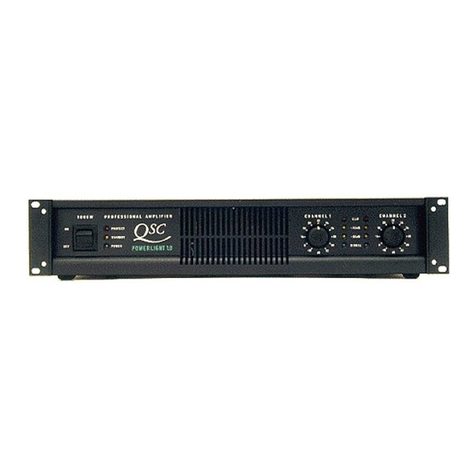
QSC
QSC PL-1.0 user manual

AR
AR 1000W1000G Operating and service manual
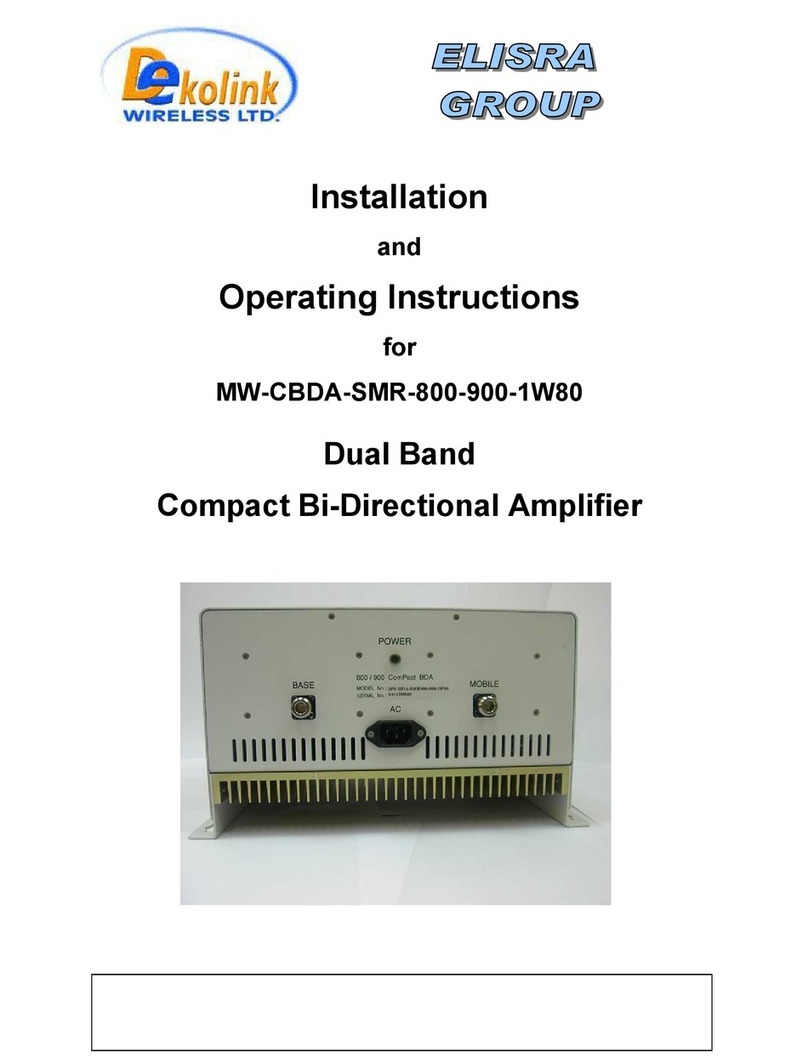
Dekolink Wireless
Dekolink Wireless MW-CBDA-SMR-800-900-1W80 Installation and operating instructions

Directed Audio
Directed Audio 250d owner's manual
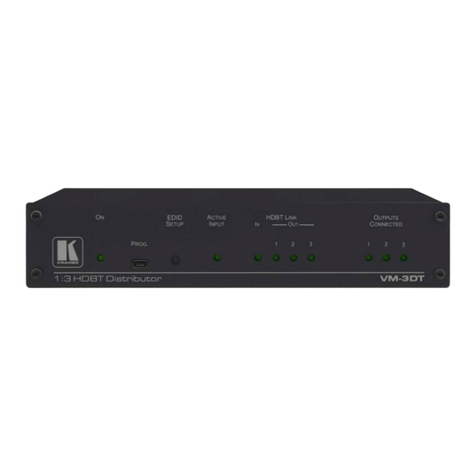
Kramer
Kramer VM-3DT quick start guide
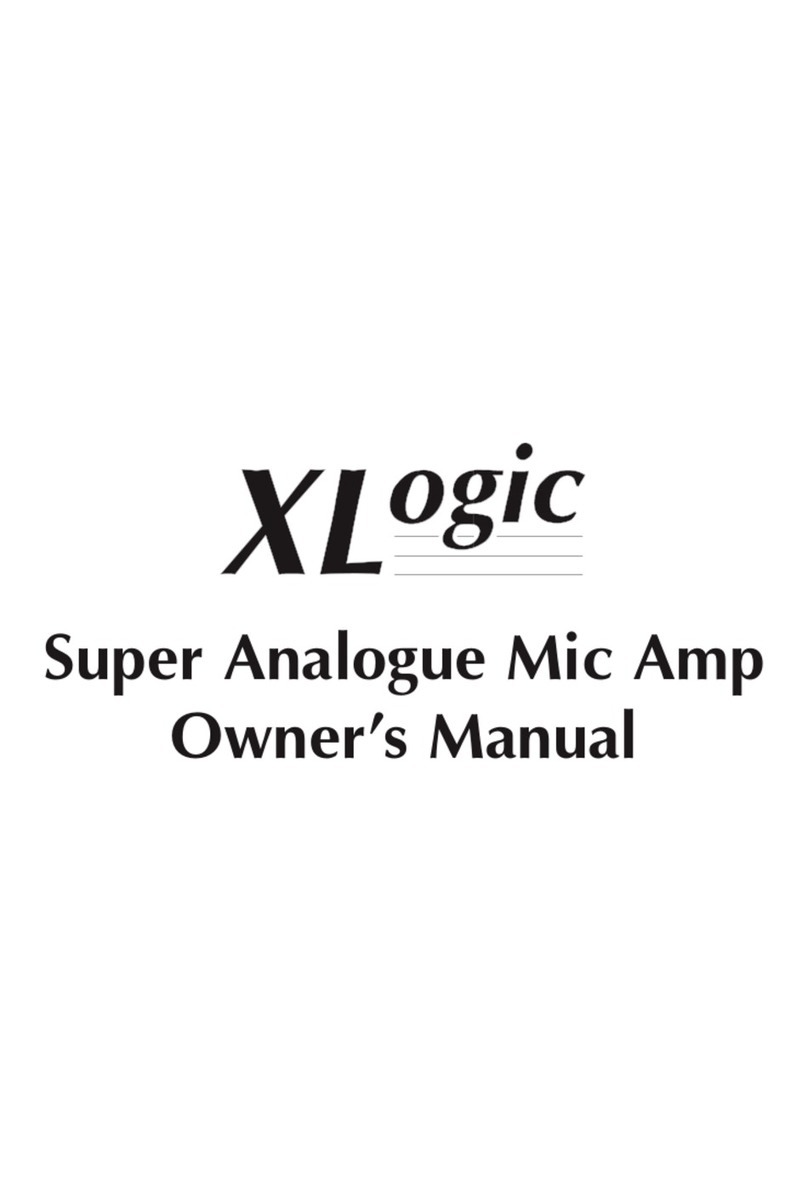
Solid State Logic
Solid State Logic 82S6XL020E owner's manual

